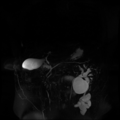| Magnetic resonance cholangiopancreatography | |
|---|---|
 MRCP image showing stones in the distal common bile duct: (a) Gallbladder with stones, (b) Stones in bile duct, (c) Pancreatic duct, (d) Duodenum. | |
| ICD-9-CM | 88.97 |
| MeSH | D049448 |
| OPS-301 code | 3-843 |
Magnetic resonance cholangiopancreatography (MRCP) is a medical imaging technique. It uses magnetic resonance imaging to visualize the biliary and pancreatic ducts non-invasively. This procedure can be used to determine whether gallstones are lodged in any of the ducts surrounding the gallbladder.


